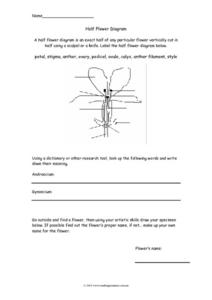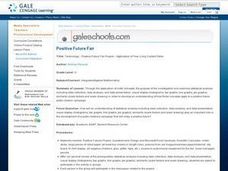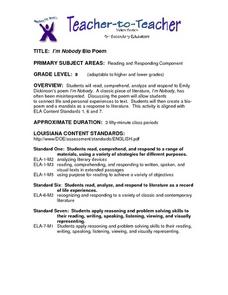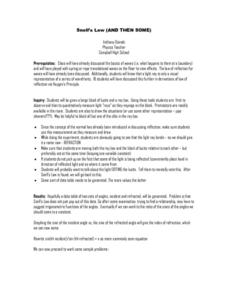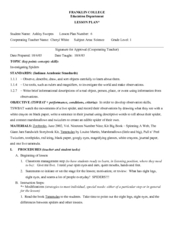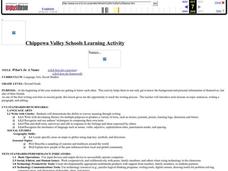Minnesota Literacy Council
Adult Computer and Employment Skills
Whether you are an experienced computer user or a newcomer to technology, a packet full of computer vocabulary, tips, and guided practice is sure to enhance your technological knowledge. Learners can hone their word processing skills and...
Yummy Math
How Much Wrapping Paper Can You Save?
Give the ultimate gift this holiday season: Christmas-themed math skills! Young gift givers calculate the amount of wrapping paper that should be used for a particular wrapping method.
Read Works
Edison Tried and Tried Again
How many times did it take Thomas Edison to invent a successful working lightbulb? Young learners read a short passage about this famous inventor and his determination in getting an idea to work successfully. Then, pupils respond to four...
Curated OER
Tooling Around Arizona: Reading Arizona Maps
Students study geography. In this Arizona maps lesson, students develop their map reading skills. They have class discussions and work independently with various copies of Arizona maps to practice those skills. This lesson mentions...
Curated OER
Lesson 4: Cartoons
Students write cartoons using a Microsoft program. In this writing lesson, students use Microsoft Chat to develop a cartoon with an anti-smoking message. They follow the directions that are given and look at a student made exemplar.
Curated OER
Measurement
Fifth graders measure specified distances when given perpendicular lines. In this measurement lesson plan, 5th graders draw the lines themselves.
Curated OER
Investigating Crickets and Their Body Parts
Second graders investigate the body of a cricket. In this biology lesson students use tools to gain information about the insect the cricket. Students observe and identify features and describe how these features help the cricket live in...
Curated OER
Half Flower Diagram
In this half flower diagram instructional activity, students label flower parts on a "half flower" diagram, use a dictionary/research tool to write definitions for 2 given words, and draw a picture of a flower they find.
Curated OER
Positive Future Fair Project
Ninth graders view the film "Pay It Forward" and discuss what kind of public campaign is needed to move people to positive action. They consider different ways of presenting information (graphs, visual displays, etc.) as tools for...
Curated OER
I'm Nobody Bio Poem
Eighth graders analyze Emily Dickinson's poem, I'm Nobody. After discussing it, they create their own bio poem. They draw and label mandalas and display them in class.
Curated OER
Prime and Composite Numbers
Fifth graders use prime factorization to identify prime and composite numbers. They use cubes to find factors. In groups, 5th graders draw rectangular arrays to discover prime numbers under 100.
Curated OER
Snell's Law (And Then Some)
Students conduct an experiment to test Snell's Law using a block of lucite and a ray box. They measure the light rays as they impinge upon the block. Students are also asked to draw the situation of the lab or create a model of the...
Curated OER
Spelling Word Flashcards
First graders draw pictures of spelling words. For this spelling lesson, 1st graders create flashcards by drawing a picture of each of the spelling words on one side and writing the actual word on the other side.
Curated OER
Observation Skills
First graders observe a spider and write sentences about what they see the spider doing. In this writing lesson plan, 1st graders draw what they see, then make an edible spider out of marshmallows and twizzlers. A fun, delicious lesson...
Curated OER
China CultureQuest
Students use the internet and other tools to examine the culture of China. In groups, they brainstorm a list of topics they want to know more about and practice writing Chinese letters. They create a collage to show the class what...
Curated OER
Introduction to Time
Students explore the concept of time. Through discussion and artistic projects, they define time in their own words and tell how it is used to represent the seasons. Students draw a picture to portray time as it elapses during the...
Curated OER
How Do You Measure...
In this measurement math/language worksheet, students see and study labeled picture, 5 in a vertical row. Students draw a line to match the object with the appropriate measuring tool.
Curated OER
Storytelling: Carnival Crime
Young scholars participate in the storytelling process. In this language arts lesson, students listen to a story and retell the story using pictures. Young scholars draw pictures of a carnival costume.
Curated OER
Rivers that Flow from the Continental Divide: The Journey of Two Rivers
Students explore river routes. In this social studies lesson, students trace the route of a river from its source and discuss the Continental Divide. Students draw the route the river takes and name the states it flows through. Students...
Curated OER
Mapping Roxaboxen
Fourth graders read Roxaboxen and draw a map of the Roxaboxen community. In this language arts and geography instructional activity, 4th graders use specifications given, adding features to the map as described in the book and creating a...
Curated OER
Taste Test
Third graders, in groups, complete a science lab in which they perform a blind taste test on eight different foods--some sweet, sour, salty, and bitter. They determine which parts of the tongue "taste" which kinds of foods. they record...
Curated OER
What's In A Name
Second graders write a paragraph about their findings on what their name represents. In this writing lesson plan, 2nd graders will research their name and why they were named that. They will draw a picture that represents them along with...
Curated OER
Four Armed Men From the Renaissance!
Students study the Renaissance and the important art from the period. In this Renaissance lesson, students discuss the black plague and religion during the Renaissance. Students read the Renaissance worksheet and learn vocabulary words...
Curated OER
Bon Voyage: Travel and Exploration
Students use the internet and other media to locate and collect information about travel. They interpret the information they collect and convert American currency to foreign currency. Students create scale drawings of travel cards.









